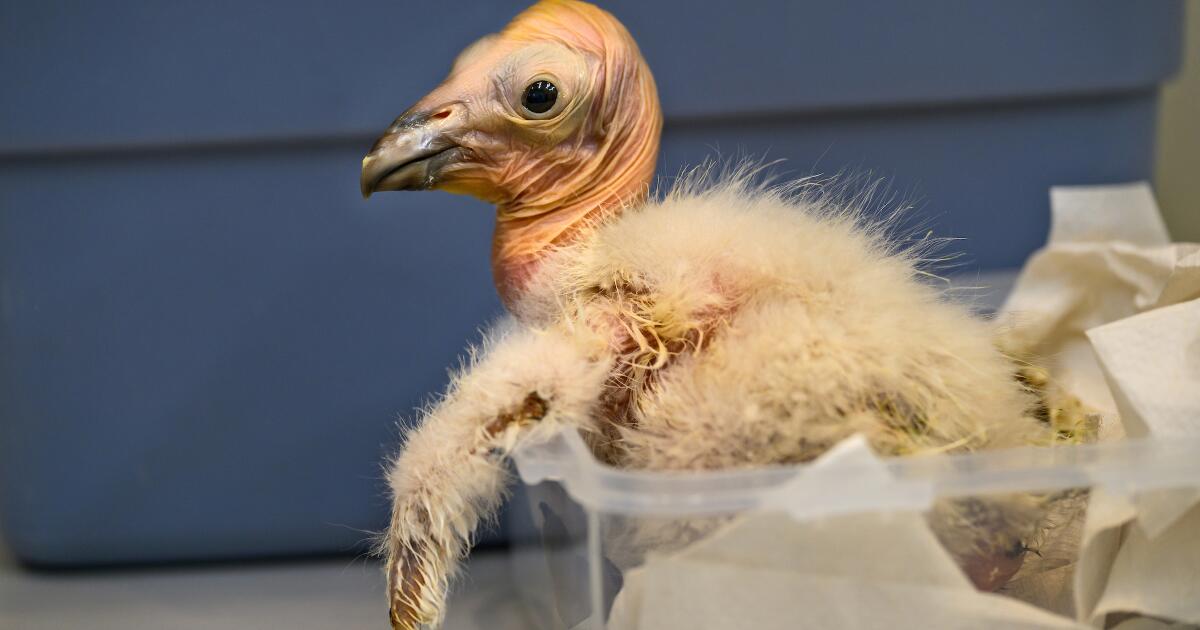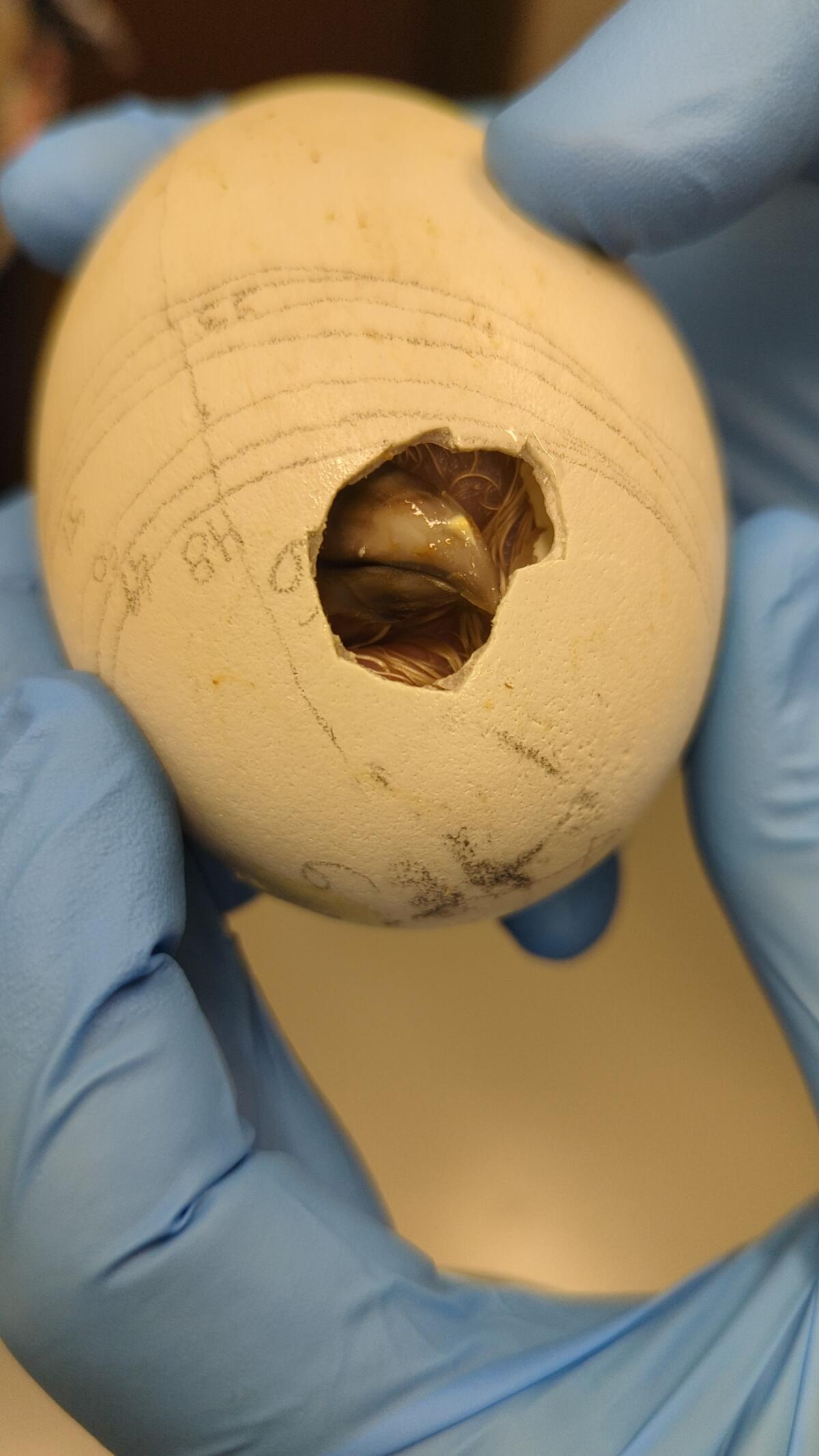Science
Could a monthly treatment prevent fentanyl overdoses? Scientists are working on it

Scientists have developed an antibody treatment that shows promise in blocking the potentially deadly effects of fentanyl for nearly a month, raising hopes for a new tool to combat overdoses.
Tests in animals found that the treatment could effectively block the effects of fentanyl, laying the groundwork for assessing whether the medication will prove effective in humans, according to a study published Tuesday in the journal Nature Communications.
The antibodies are too big to cross the blood-brain barrier, so when they bind to fentanyl in the bloodstream, they stop the powerful opioid from reaching receptors in the brain, researchers explained. The experimental treatment, dubbed CSX-1004, was administered to animals via an intravenous infusion.
Andrew Barrett, chief scientific officer for Cessation Therapeutics, the company that developed the treatment, likened the way it works to “Pac-Man” snapping up fentanyl in the blood, which “prevents fentanyl from ever getting to the brain where it produces its effects,” both pleasurable and dangerous.
Among its possible uses: The infusion could be given as a preventive measure to patients who complete an inpatient detoxification program “to try to prevent a death in the event of a relapse,” Barrett said.
Finding such a tool has been especially urgent as the number of American lives lost to drug overdoses has climbed to more than 100,000 a year, according to federal data. The bulk of those deaths have been linked to synthetic opioids such as fentanyl, a potent drug that has also been found in counterfeit pills and is often mingled with other drugs such as methamphetamine.
Scientists at Cessation Therapeutics in San Diego, teaming up with researchers from Harvard Medical School and McLean Hospital in Massachusetts, performed a series of tests in rodents and squirrel monkeys to gauge CSX-1004’s effects and found that a single infusion protected the primates from fentanyl for more than three weeks.
One set of experiments included eight monkeys who were given fentanyl multiple times over 28 days. The animals first received a placebo to see how they responded to the opioid without treatment. Later, they received either a low or high dose of CSX-1004 at the outset of the cycle and were given fentanyl six times.
Breathing measurements showed the medicine was most protective for the first week and waned steadily after that, with the higher dose showing significant effects for as long as 28 days.
The experimental treatment reversed slowed or shallow breathing, an overdose symptom that can lead to death, researchers reported. And it worked on other dangerous fentanyl analogs like carfentanil —a synthetic opioid intended for sedating large animals — without affecting oxycodone or other opioids prescribed by doctors for pain management, the study authors found.
Cessation Therapeutics has started assessing the safety of the treatment in human volunteers and plans to next gauge its effects in people with opioid dependency, Barrett said. If CSX-1004 proves effective in clinical trials, the researchers said, it could protect people who are at high risk of overdose and become a bridge to other treatments that address craving and withdrawal symptoms, researchers wrote.
“We’re in that crisis situation where we need all hands on deck to help prevent people from dying,” said Kelly E. Dunn, a professor of psychiatry and behavioral sciences at the Johns Hopkins University School of Medicine who advised the company on the design for human trials of the medication but was not involved in data collection for the new study.
“These transformative approaches are exactly what we need,” because with existing tools, “we’re just not making the headway that we would hope.”
Arming people with antibodies has long been explored by researchers as a potential way to protect people from a range of addictive drugs.
With fentanyl deaths up sharply since the start of the COVID-19 pandemic, the research on antibody treatments “really opens a door for a tool that will help us address very high-risk populations,” said Dr. Nora Volkow, director of the National Institute on Drug Abuse, which funded the new research. Among them are people exiting jails or prisons, who face an alarmingly high risk of overdose in the weeks after they are released, she said.
Volkow added that the treatment could help protect people who use cocaine or methamphetamine, who are in danger of overdosing when their drugs are contaminated with fentanyl. For those people, she said, “you will dramatically reduce the risk for dying.”
The antibodies could have advantages over extended-release naltrexone, a medication that blocks the effects of opioids, Barrett said. Monthly injections of naltrexone require people to abstain from opioids for a while before beginning the medication.
“Your tolerance goes down very quickly” in that time, said Dr. Melissa B. Weimer, an associate professor of medicine and public health at Yale who was not involved in the study. As they undergo withdrawal, “most people who have severe opioid use disorder will be quite uncomfortable during that period of time. That places them at risk to not start treatment,” leaving them unprotected and at higher risk of opioid overdose.
In addition, people taking naltrexone cannot use other common medications to reduce opioid cravings such as methadone. And because naltrexone blocks all opioids, it can complicate pain management in emergencies. Based on the findings so far, CSX-1004 doesn’t share those drawbacks, Barrett said.
The research team is still studying whether CSX-1004 causes “precipitated withdrawal” — an abrupt and sickening experience that people have suffered with some treatments for opioid use disorder. “We don’t know the answer yet, but we don’t think it will be a profound withdrawal” because of the way it works, Barrett said.
Weimer said that another important question is what happens if people use more fentanyl to try to override the effects of the medication. Physicians will need to know if people could be at higher risk of overdose as the effects of the medication wear off, she said.
And then there is the practical question of “what proportion of individuals would opt for this treatment,” said Dr. Larissa Mooney, an addiction psychiatrist at UCLA. “People who choose this therapy option would have to be motivated to receive a treatment that will reduce the effects of fentanyl.”
Scientists have also tried to develop vaccines that prompt the body to produce antibodies that can protect against fentanyl and other illicit drugs. Dr. Thomas Kosten, a psychiatrist at Baylor College of Medicine who has been working on a fentanyl vaccine, said antibody-based therapies might have some practical drawbacks.
The cost of making monoclonal antibodies like CSX-1004 is “rather high,” Kosten said, and “you can’t just store a monoclonal in your closet, you have to refrigerate it. … So in some ways, it’s not a practical solution to what’s a huge problem.” He also questioned whether health insurers would cover the costs of an infusion treatment for substance use disorder.
Volkow said that if a treatment like CSX-1004 proves effective in humans, “there is a lot of room for innovation” to address practical issues. “It would make sense to do that innovation if it does look like it’s going to work.”
Cessation Therapeutics said it is already developing an injectable version of the antibody treatment that could be more convenient. In the new paper, the authors wrote that monoclonal antibodies could be priced around the same level as some existing treatments for opioid use disorder.
Dunn of Johns Hopkins University urged more investment in new medications and approaches to thwart overdoses. There is “very little general investment in this area,” she said, despite the alarming number of lives lost. “We need that investment to be able to really make big changes.”

Science
Q&A: Learn how Olympians keep their cool from Team USA's chief sports psychologist

Your morning jog or weekly basketball game may not take place on an Olympic stage, but you can use Team USA’s techniques to get the most out of your exercise routine.
It’s not all about strength and speed. Mental fitness can be just as important as physical fitness.
That’s why the U.S. Olympic & Paralympic Committee created a psychological services squad to support the mental health and mental performance of athletes representing the Stars and Stripes.
“I think happy, healthy athletes are going to perform at their best, so that’s what we’re striving for,” said Jessica Bartley, senior director of the 15-member unit.
Bartley studied sports psychology and mental health after an injury ended her soccer career. She joined the USOPC in 2020 and is now in Paris with Team USA’s 592 competitors, who range in age from 16 to 59.
Bartley spoke with The Times about how her crew keeps Olympic athletes in top psychological shape, and what the rest of us can learn from them. Her comments have been edited for length and clarity.
Why is exercise good for mental health?
It gets you moving. It gets the endorphins going. And there’s often a lot of social aspects that are really helpful.
There are a number of sports that stretch your brain in ways that can be really, really valuable. You’re thinking about hand-eye coordination, or you’re thinking about strategy. It can improve memory, concentration, even critical thinking.
What’s the best way to get in the zone when it’s time to compete?
When I work with athletes, I like to understand what their zone is. If a 0 or a 1 is you’re totally chilled out and a 10 is you’re jumping around, where do you need to be? What’s your number?
People will say, “I’m at a 10 and I need to be at an 8 or a 7.” So we’ll talk about ways of bringing it down, whether it’s taking a deep breath, listening to relaxing music, or talking to your coach. Or there’s times when people say they need to be more amped up. That’s when you see somebody hitting their chest, or jumping up and down.
If you make a mistake in the middle of a competition, how do you move on instead of dwelling on it?
I often teach athletes a reset routine. I played goalie, so I had a lot of time to think after getting scored on. I would undo my goalie gloves and put them back on, which to me was a reset. I would also wear an extra hairband on my wrist, and when I would snap it, that meant I needed to get out of my head.
It’s not just a physical reset — it helps with a mental reset. If you do the same thing every single time, it goes through the same neural pathway to where it’s going to reset the brain. That can be really impactful.
Do Olympic athletes have to deal with burnout?
Oh, yeah. Everybody has a day where they don’t want to do whatever it is. That’s when you have to ask, “What’s in my best interests? Do I need a recovery day, or do I really need to get in the pool, or get in the gym?”
Sometimes you really do need what we like to refer to as a mental health day.
How can you psych yourself up for a workout when you just aren’t feeling it?
It’s really helpful to think about why you’re doing this and why you’re pushing yourself. Do you have goals related to an activity or sport? Is there something tied to values around hard work or discipline, loyalty or dependability?
When you don’t want to get in the gym, when you don’t want to go for a run, think about something bigger. Tie it back to values.
Is sleep important for maintaining mental health?
Yes! We started doing mental health screens with athletes before the Tokyo Games. We asked about depression, anxiety, disordered eating and body image, drugs and alcohol, and sleep. Sleep was actually our No. 1 issue. It’s been a huge initiative for us.
How much sleep should we be getting?
It’s different for everyone, but generally we know seven to nine hours of sleep is good. Sometimes some of these athletes need 10 hours.
I highly recommend as much sleep as you need. If you didn’t get enough sleep, napping can be really valuable.
Is napping just for Olympic athletes or is it good for everybody?
Everybody! Naps are amazing.
What if there’s no time for a nap?
There are different ways of recharging. Naps could be one of them, but maybe you just need to get off your feet for 20 minutes. Maybe you need to do a meditation or mindfulness exercise and just close your eyes for five minutes.
How do you minimize the effects of jet lag?
We try to shift one hour per day. That’s the standard way of doing it. If you can, it’s super helpful. But it’s not always possible.
The thing we tell athletes is that our bodies are incredible, and you will even things out if you can get back on schedule. One or two nights of crummy sleep is not going to impact your overall performance.
What advice do you give athletes who have trouble falling asleep the night before a competition?
You don’t want to change much right before a competition, so I usually direct athletes to do what they would normally do.
Do you need to unwind by reading a book? Do you need to talk on the phone with somebody and get your mind off things? Can you put your mind in a really restful place and think about things that are really relaxing?
Are there any mindfulness or meditation exercises that you find helpful?
There are some athletes who benefit greatly from an hourlong meditation. I love something quick, something to reset my brain, maybe close my eyes for a minute.
If I’m feeling like I need to take a moment, I love mindful eating. You savor a bite and go, “Oh, my gosh, I have not been fully engaged with my senses today.” Or you could take a mindful walk and take in the sights, the smells, all of the things that are around you.
What do you eat when you need a quick nutrition boost?
Cashews. I tend to carry those with me. They’ve got enough energy to make sure I keep going, physically.
I’ve always got gummy bears on me too. There’s no nutritional value but they keep me going mentally. I’m a big proponent of both.
Is it OK to be superstitious in sports?
It depends how flexible you are. Maybe you put on your socks or shoes a certain way, or listen to certain music. Routines are really soothing. They set your brain up for success in a particular performance. It can be really, really helpful.
But I’ve also seen an athlete forget their lucky underwear or their lucky socks, and they’re all out of sorts. So your routine has to be flexible enough that you’re not going to completely fall apart if you don’t do it exactly.
Are Olympians made of stronger psychological stuff than the rest of us?
Not necessarily. There are some who don’t get feathers ruffled and have a high tolerance for the fanfare. There’s also a lot of regular human beings who just happen to be fantastic at a particular activity.
Science
‘Ready, Steady, Slow’: Championship Snail Racing at 0.006 M.P.H.

Earlier this month, the rural village of Congham, England, played host to a less likely group of athletes: dozens of garden snails. They had gathered to compete in the World Snail Racing Championships, where the world record time for completing the 13.5 inch course stands at 2 minutes flat. At that speed — roughly 0.006 miles per hour — it would take the snails more than six days to travel a mile.
Science
Caring for condor triplets! Record 17 chicks thrive at L.A. Zoo under surrogacy method

A new method of rearing California condors at the Los Angeles Zoo has resulted in a record-breaking 17 chicks hatched this year, the zoo announced Wednesday.
All of the newborn birds will eventually be considered for release into the wild under the U.S. Fish and Wildlife Service’s California Condor Recovery Program, a zoo spokesperson said.
“What we are seeing now are the benefits of new breeding and rearing techniques developed and implemented by our team,” zoo bird curator Rose Legato said in a statement. “The result is more condor chicks in the program and ultimately more condors in the wild.”
Breeding pairs of California condors live at the zoo in structures the staff “affectionately calls condor-miniums,” spokesperson Carl Myers said. When a female produces a fertilized egg, the egg is moved to an incubator. As its hatching approaches, the egg is placed with a surrogate parent capable of rearing the chick.
California condor eggs are cared for at L.A. Zoo. The animal is critically endangered.
(Jamie Pham / L.A. Zoo)
This bumper year of condor babies is the result of a modification to a rearing technique pioneered at the L.A. Zoo.
Previously, when the zoo found itself with more fertilized eggs than surrogate adults available, staff raised the young birds by hand. But condors raised by human caretakers have a lower chance of survival in the wild (hence the condor puppets that zookeepers used in the 1980s to prevent young birds from imprinting on human caregivers).
In 2017, the L.A. Zoo experimented with giving an adult bird named Anyapa two eggs instead of one. The gamble was a success. Both birds were successfully released into the wild.
Faced with a large number of eggs this year, “the keepers thought, ‘Let’s try three,’” Myers said. “And it worked.”
The zoo’s condor mentors this season ultimately were able to rear three single chicks, eight chicks in double broods and six chicks in triple broods. The previous record number of 15 chicks was set in 1997.
Condor experts applauded the new strategy.
“Condors are social animals and we are learning more every year about their social dynamics. So I’m not surprised that these chick-rearing techniques are paying off,” said Jonathan C. Hall, a wildlife ecologist at Eastern Michigan University. “I would expect chicks raised this way to do well in the wild.”
The largest land bird in North America with an impressive wingspan up to 9½ feet, the California condor could once be found across the continent. Its numbers began to decline in the 19th century as human settlers with modern weapons moved into the birds’ territory. The scavenger species was both hunted by humans and inadvertently poisoned by lead bullet fragments embedded in carcasses it ate. The federal government listed the birds as an endangered species in 1967.

A condor, one of a record-breaking 17 at the zoo, makes its way out of its shell.
(Jamie Pham / L.A. Zoo)
When the California Condor Recovery Program began four decades ago, there were only 22 California condors left on Earth. As of December, there were 561 living individuals, with 344 of those in the wild. Despite the program’s success in raising the population’s numbers, the species remains critically endangered.
In addition to the ongoing threat of lead poisoning, the large birds are also at risk from other toxins. One 2022 study found more than 40 DDT-related compounds in the blood of wild California condors — chemicals that had made their way from contaminated marine life to the top of the food chain.
“Despite our success in returning condors to the wild, free-flying condors continue to face many obstacles with lead poisoning being the No. 1 cause of mortality,” said Joanna Gilkeson, spokesperson for Fish and Wildlife’s Pacific Southwest Region. “Innovative strategies, like those the L.A. Zoo is implementing, help us to produce more healthy chicks and continue releasing condors into the wild.”
The chicks will remain in the zoo’s care for the next year and a half before they are evaluated for potential release to the wild. Thus far, the zoo has contributed 250 condor chicks to Fish and Wildlife’s program, some of which the agency has redeployed to other zoos as part of its conservation efforts.
In a paper published earlier this year, a team of researchers found that birds born in captivity have slightly lower survival rates for their first year or two but then have equally successful outcomes to wild-hatched birds.
“Because condors reproduce slowly, releases of captive-bred birds are essential to the recovery of the species, especially in light of ongoing losses due to lead-related mortality,” said Victoria Bakker, a quantitative ecologist at Montana State University and lead author of the paper. “The team at the L.A. Zoo should be recognized for their innovative and important contributions to condor recovery.”
-

 World1 week ago
World1 week agoOne dead after car crashes into restaurant in Paris
-

 Midwest1 week ago
Midwest1 week agoMichigan rep posts video response to Stephen Colbert's joke about his RNC speech: 'Touché'
-

 News1 week ago
News1 week agoVideo: Young Republicans on Why Their Party Isn’t Reaching Gen Z (And What They Can Do About It)
-

 Movie Reviews1 week ago
Movie Reviews1 week agoMovie Review: A new generation drives into the storm in rousing ‘Twisters’
-

 News1 week ago
News1 week agoIn Milwaukee, Black Voters Struggle to Find a Home With Either Party
-

 Politics1 week ago
Politics1 week agoFox News Politics: The Call is Coming from Inside the House
-

 News1 week ago
News1 week agoVideo: J.D. Vance Accepts Vice-Presidential Nomination
-

 World1 week ago
World1 week agoTrump to take RNC stage for first speech since assassination attempt















